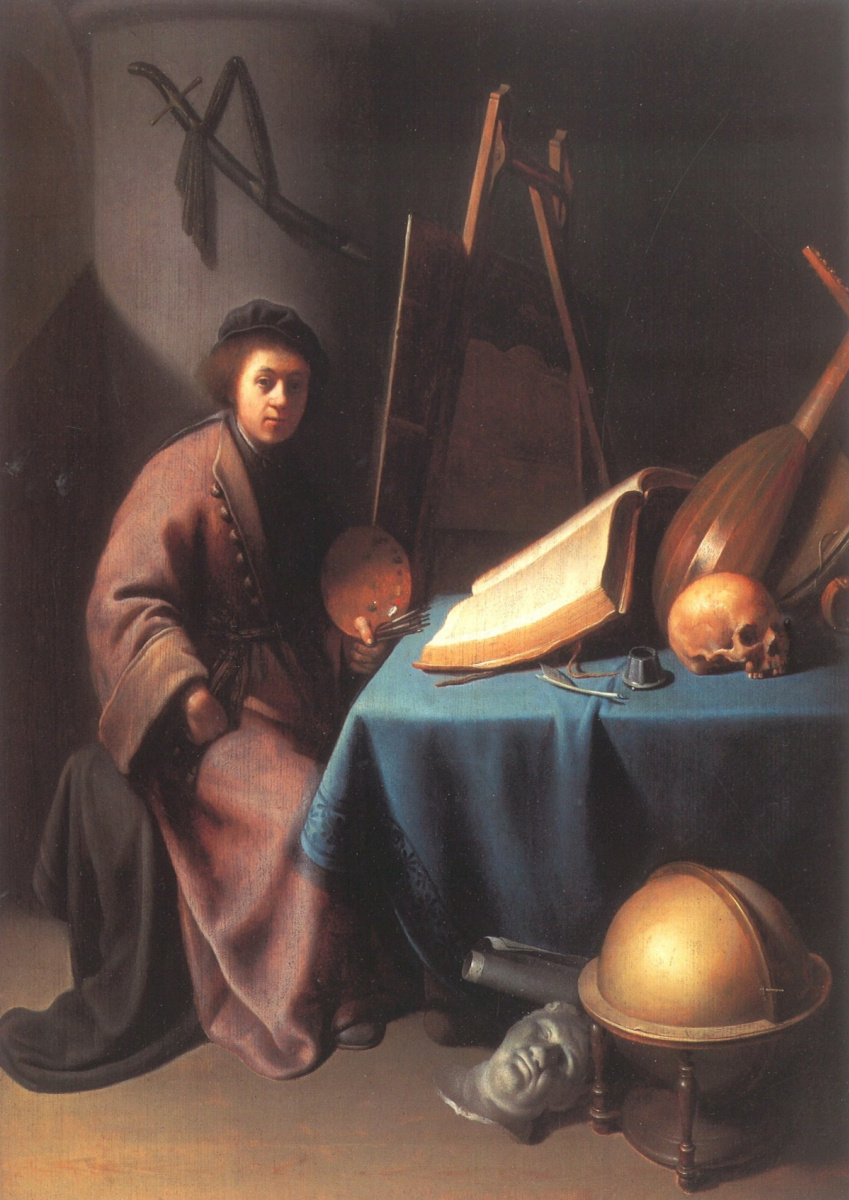log in
Enter site
Login to use Arthive functionality to the maximum
The painter in his workshop
Gerrit (Gerard) Dow • Painting, 1630, 59×43.5 cm
Description of the artwork «The painter in his workshop»
Art critics often use The Painter in His Workshop to illustrate the influence of his teacher, Rembrandt van Rijn. on Gerrit Dou. This panel is often compared to the eponymous work by the latter, which had been painted around 1628. It was then that a fifteen-year-old Dow became the first student of the 21-year-old Rembrandt.
The subtle, loose overlay of paint, the purplish-brown robe of the sitter, and the teal-blue tint of the tablecloth are characteristic of the early Dou style. Many objects — the open book, the globe, the quill and the inkwell — appear in his other works of the same period, such as Man with Easel or Scholar Interrupted at His Writing. Man with Easel or Scholar Interrupted at His Writing. The Painter in His Workshop has a lot in common with the latter work, especially in terms of the use of chiaroscuro, which creates an almost perceptible atmosphere enveloping the figure and objects.
One of the researchers identified the young man in the picture as Rembrandt, the second as Dou himself, but in fact, there is no resemblance to either one or the other. The paintings of the teacher and the student are united by a monochrome palette vivified by a bluish-green stripe, a special manner of applying paint and a significant contrast of light and shadow. In both portraits, the artist holds a palette and brushes, while the easel is turned away from the viewer. The artists do not depict a specific person, but rather offer a generalized image of the Painter.
Some of Dou’s early works are so close in style to Rembrandt that there were even cases of confusion about the attribution. This was partly due to the fact that the teacher and the student shared themes and models.
However, the difference in the compositional solutions of both Painters in their Studios testifies to the different approaches of the artists to art. The face of the Rembrandt’s subject is hidden in the shadows, the easel dominates in the half-empty space and seems to be approaching him. Whereas Dou focuses on accurate and graceful portrayal of a variety of surfaces and materials. The setting and elements of the still life are proportional to the artist looking directly at the viewer.
Unlike the Rembrandt’s painting, the Dou’s work is filled with objects that could be mistaken for ordinary studio props. Nevertheless, many of them, including the globe, the plaster cast (such things appear in the artist’s later self-portraits), the skull, the lute, the books, the sword, have traditionally been associated with thoughts of the ephemerality of life. Perhaps Dou included these frailty symbols to emphasize the contrast with the longevity of the artist’s works (ars longa vita brevis — “art is eternal, life is short”).
Written by Vlad Maslov
The subtle, loose overlay of paint, the purplish-brown robe of the sitter, and the teal-blue tint of the tablecloth are characteristic of the early Dou style. Many objects — the open book, the globe, the quill and the inkwell — appear in his other works of the same period, such as Man with Easel or Scholar Interrupted at His Writing. Man with Easel or Scholar Interrupted at His Writing. The Painter in His Workshop has a lot in common with the latter work, especially in terms of the use of chiaroscuro, which creates an almost perceptible atmosphere enveloping the figure and objects.
One of the researchers identified the young man in the picture as Rembrandt, the second as Dou himself, but in fact, there is no resemblance to either one or the other. The paintings of the teacher and the student are united by a monochrome palette vivified by a bluish-green stripe, a special manner of applying paint and a significant contrast of light and shadow. In both portraits, the artist holds a palette and brushes, while the easel is turned away from the viewer. The artists do not depict a specific person, but rather offer a generalized image of the Painter.
Some of Dou’s early works are so close in style to Rembrandt that there were even cases of confusion about the attribution. This was partly due to the fact that the teacher and the student shared themes and models.
However, the difference in the compositional solutions of both Painters in their Studios testifies to the different approaches of the artists to art. The face of the Rembrandt’s subject is hidden in the shadows, the easel dominates in the half-empty space and seems to be approaching him. Whereas Dou focuses on accurate and graceful portrayal of a variety of surfaces and materials. The setting and elements of the still life are proportional to the artist looking directly at the viewer.
Unlike the Rembrandt’s painting, the Dou’s work is filled with objects that could be mistaken for ordinary studio props. Nevertheless, many of them, including the globe, the plaster cast (such things appear in the artist’s later self-portraits), the skull, the lute, the books, the sword, have traditionally been associated with thoughts of the ephemerality of life. Perhaps Dou included these frailty symbols to emphasize the contrast with the longevity of the artist’s works (ars longa vita brevis — “art is eternal, life is short”).
Written by Vlad Maslov


